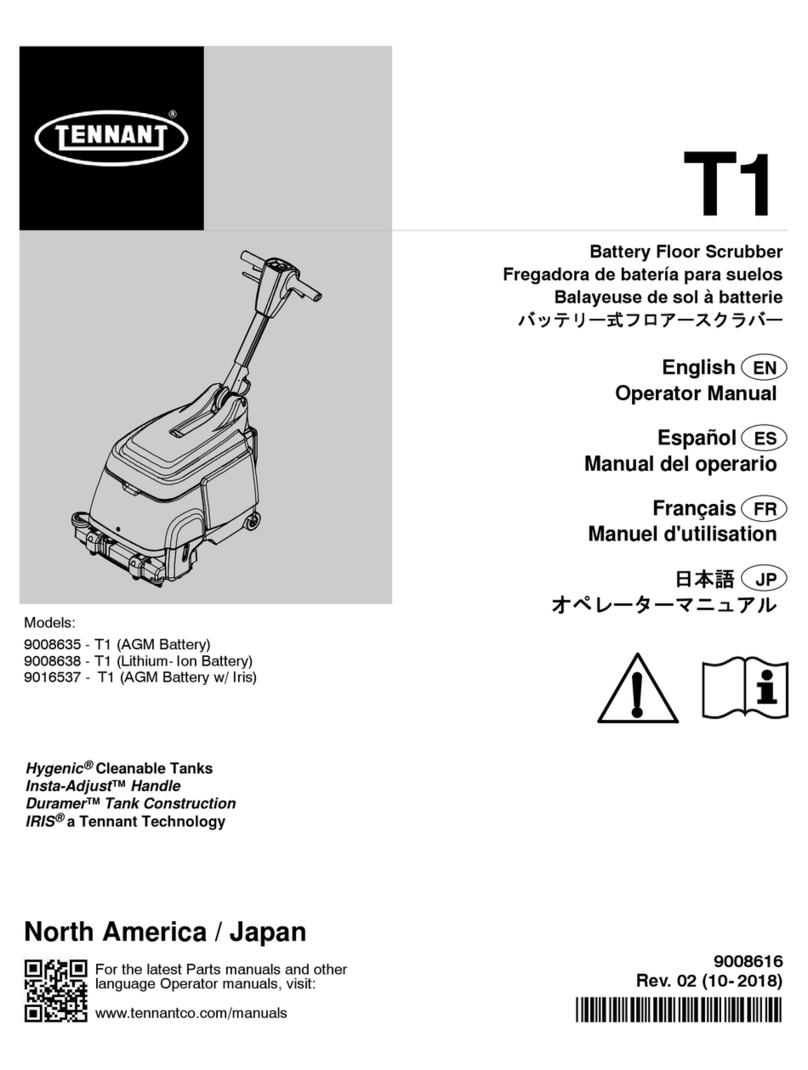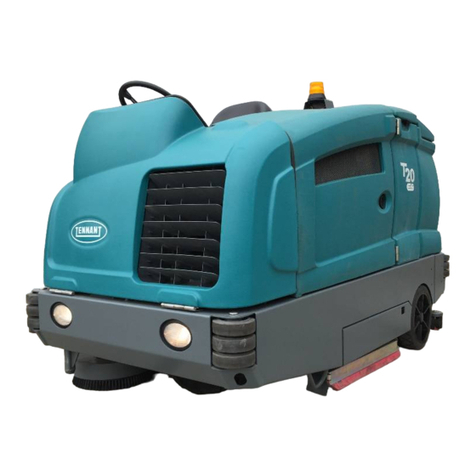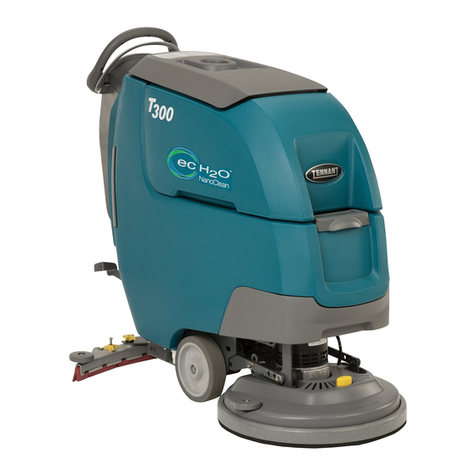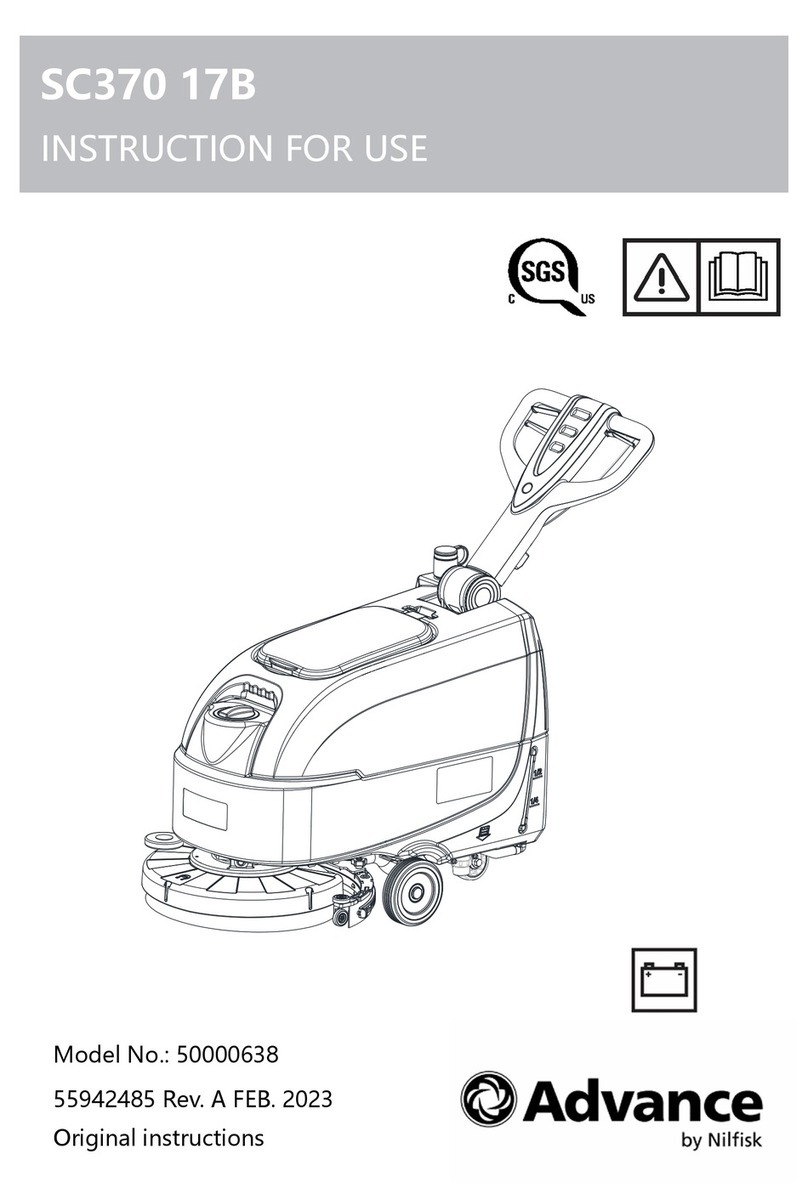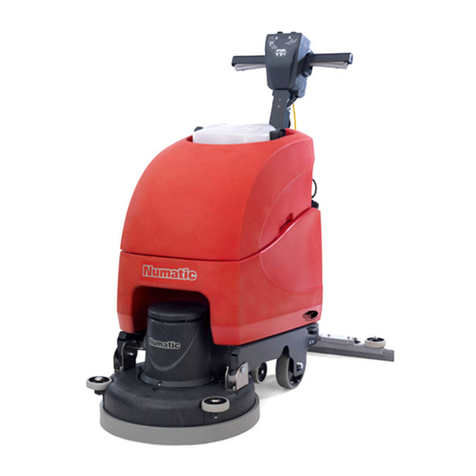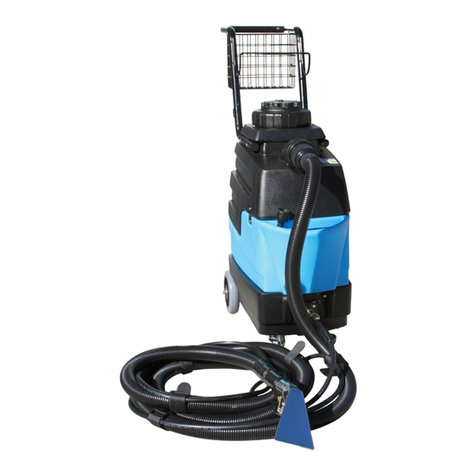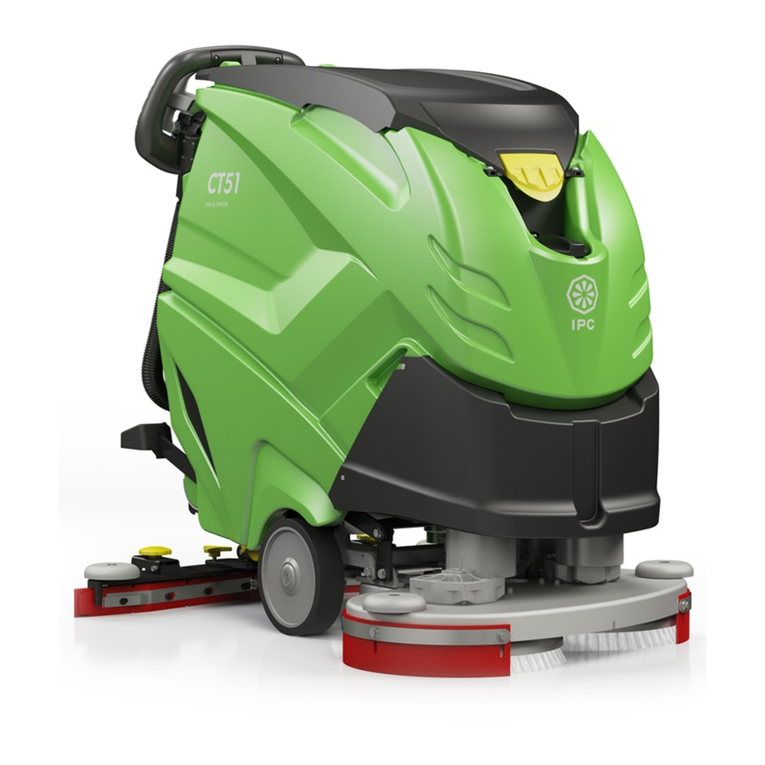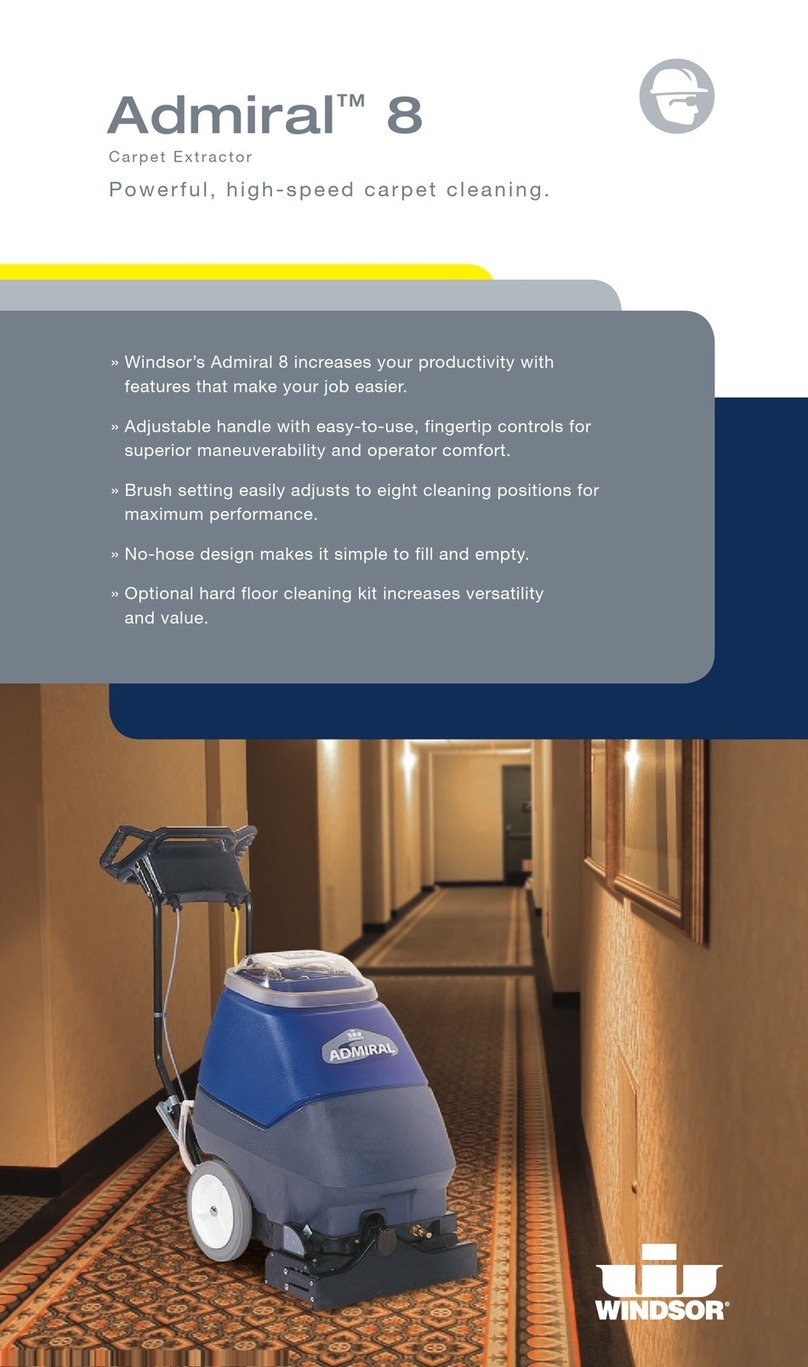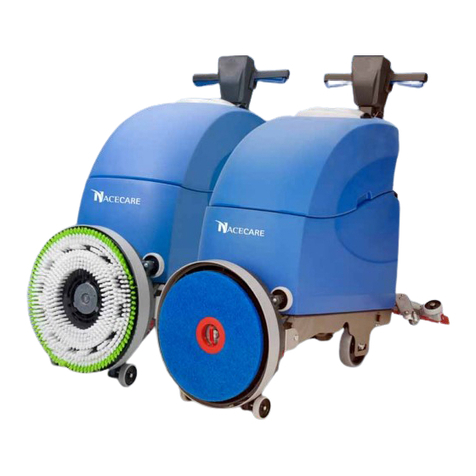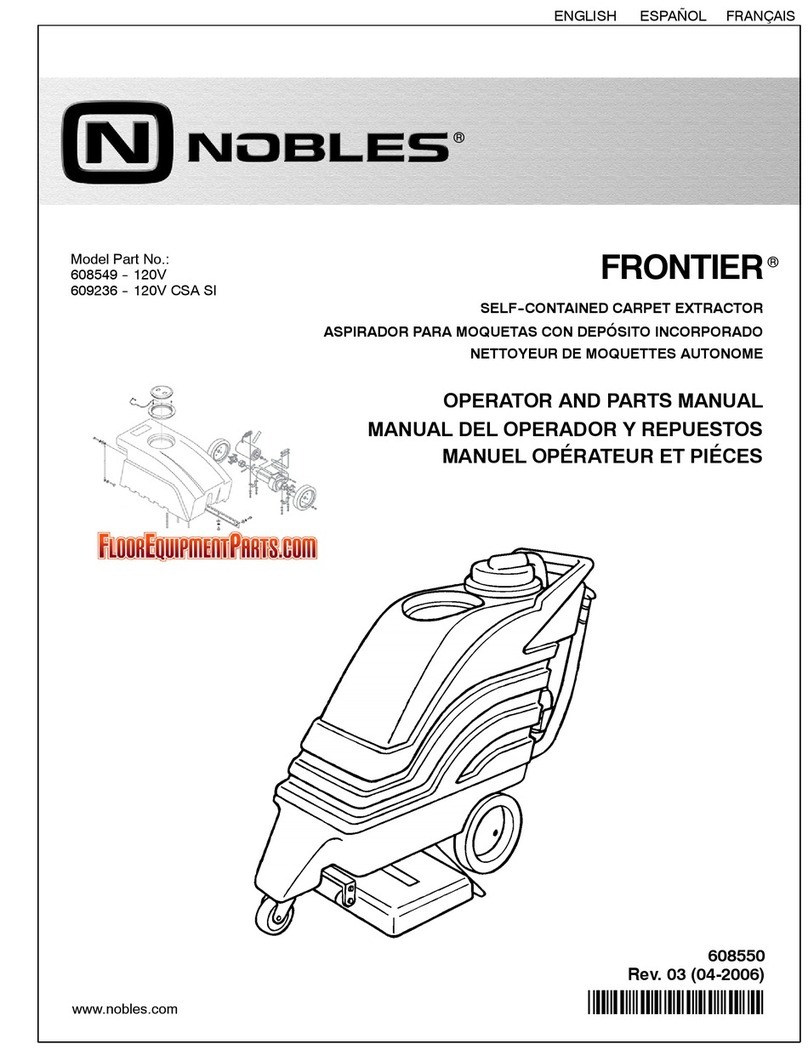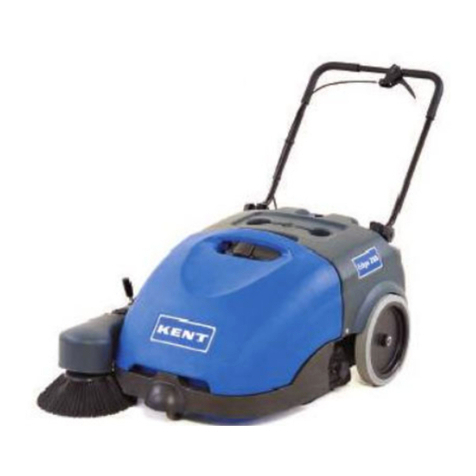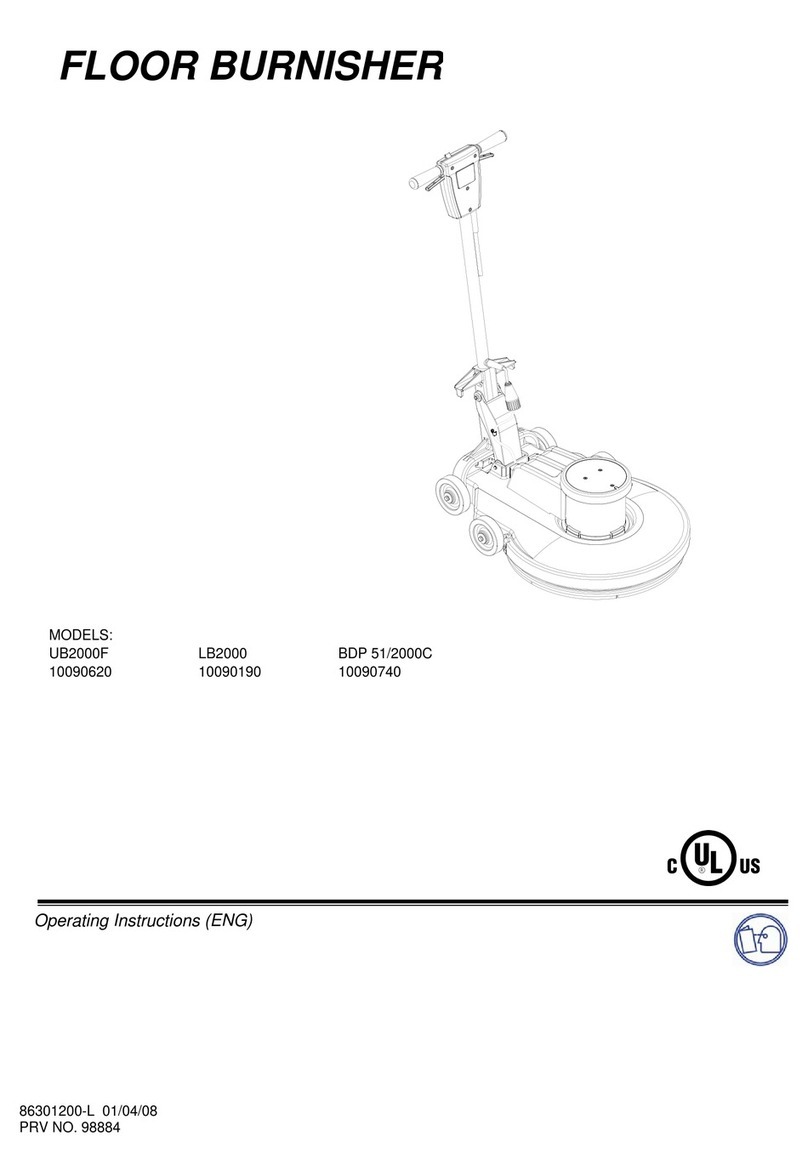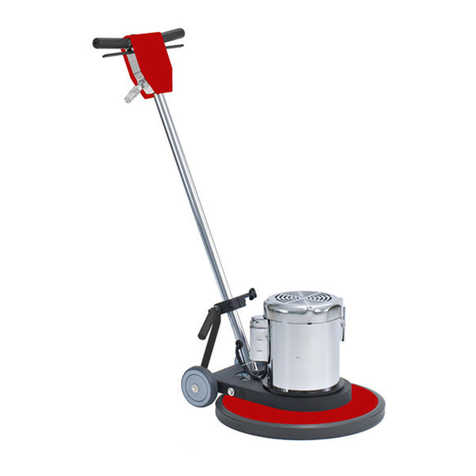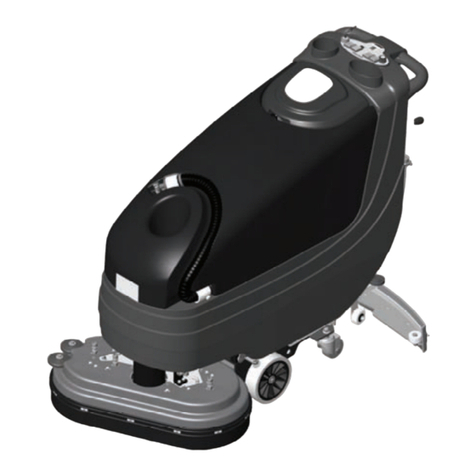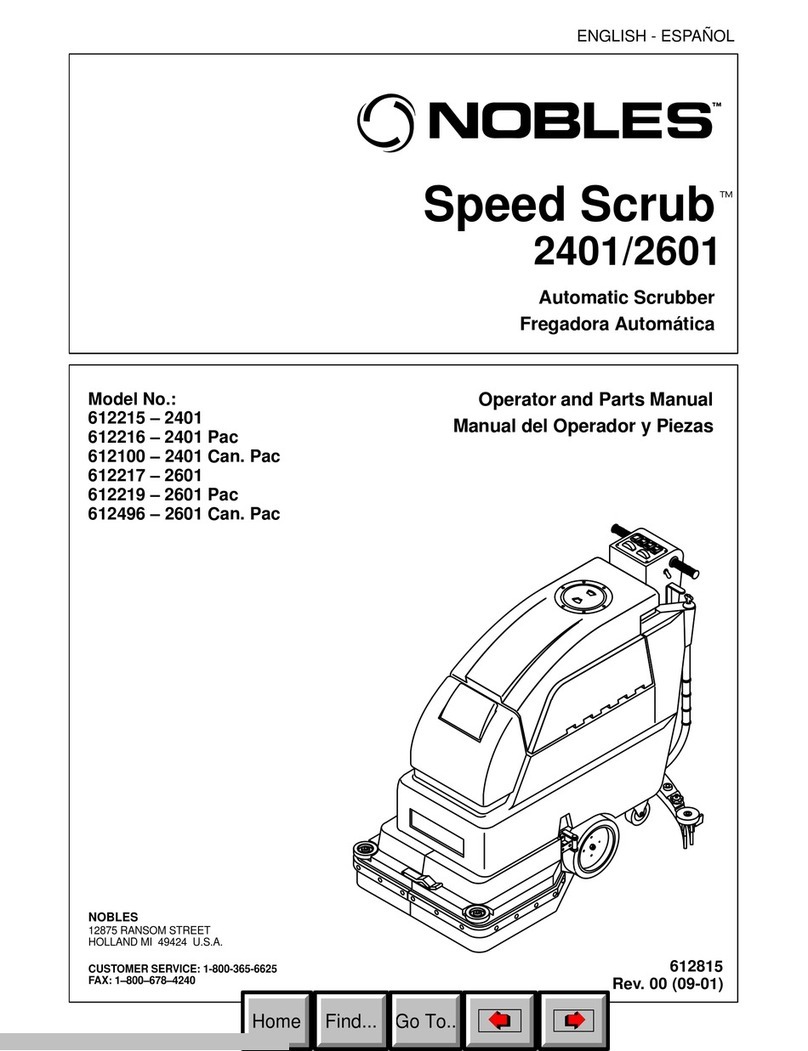Tennant 1230 Product manual

Tennant1230 (06–96)
2
IMPORTANT SAFETY INSTRUCTIONS
When using an electrical appliance, basic precautions should always be followed,
including the following:
READ ALL INSTRUCTIONS BEFORE USING (THIS APPLIANCE)
WARNING – To reduce the risk of fire, electric shock, or injury:
1. Do not leave appliance when plugged in. Unplug from outlet when not in use and before
servicing.
2. Do not use outdoors or on wet surfaces.
3. Do not allow to be used as a toy. Close attention is necessary when used by or near children.
4. Use only as described in this manual. Use only manufacturer’s recommended attachments.
5. Do not use with damaged cord or plug. If appliance is not working as it should, has been
dropped, damaged, left outdoors, or dropped into water, return it to a service center.
6. Do not pull or carry by cord, use cord as a handle, close a door on cord, or pull cord
around sharp edges or corners. Do not run appliance over cord. Keep cord away from
heated surfaces.
7. Do not unplug by pulling on cord. To unplug, grasp the plug, not the cord.
8. Do not handle plug or appliance with wet hands.
9. Do not put any object into openings. Do not use with any opening blocked; keep free of
dust, lint, hair, and anything that may reduce air flow.
10. Keep hair, loose clothing, fingers, and all parts of body away from openings and moving
parts.
11. Do not pick up anything that is burning or smoking, such as cigarettes, matches, or hot
ashes.
12. Do not use without filters and/or dust bag in place.
13. Turn off all controls before unplugging.
14. Use extra care when cleaning on stairs.
15. Do not use to pick up flammable or combustible liquids such as gasoline or use in areas
where they may be present.
16. For grounded appliance: ”Connect to a properly grounded outlet only. See Grounding
Instructions.”

3
Tennant 1230 (7–96)
LIRE TOUTES LES INSTRUCTIONS AVANT
DE FAIRE FONCTIONNER
(CET APPAREIL)
ADVERTISSEMENT – Pour réduire les risques d’incendie,
de choc électrique ou de blessure:
1. Ne pas laisser l’appareil san surveillance lorsqu’il est branché. Débrancher lorsque
l’appareil n’est pas utilisé et evant l’entretien.
2. Ne pas utuliser à l’extérieur et ne pas aspirer de matières humides.
3. Ne pas permettre aux enfants de jouer avec l’appareil. une attention particuliér est
nécessarie lorsque lappareil est utilisé par des enfants ou à proximite de ces deniers.
4. Nutiliser que conformément à cette notice avec les accessories recommandés par le
fabricant.
5. Ne pas utiliser si le cordon ou la fiche est endommagé. Retourner lappareil a un atelier
de réparation s’il ne fonctionne pas bien, s’il est tombé ou s’il a été endommage, oublie
à l’extérieur ou immergé.
6. Ne pas tirer soulever ou traîner l’appareil par le condon. Ne pas uliliser le cordon
comme une poignée, le coincer dans l’embrasure d’une porte ou l’appuyer contre des
arêtes vives ou des coins. Ne pas faire rouler l’appareil sur le cordon. Garder le cordon
à l’écart des surfaces chaudes.
7. Ne pas débracher en tirant sur le cordon. Tier plutôt la fiche.
8. Ne pas toucher la fiche ou l’appareil lorsque vos mains sont humides.
9. N’insérer aucun objet dans les ouvertures. Ne pas utiliser l’appareil losqu’une
ouverture est bloquée. S’assurer que de la poussière, de la peluche, des cheveux
ou d’autres matières ne réduisent pas le débit d’air.
10. Maintenir les cheveux, les vêtements amples, les doigts et toutes les parties du corps a
l’écart des ouvertures et des piéces mobiles.
11. Ne pas aspirer de matières en combustion ou qui dégagent de la furmée, comme des
cigarettes, des allumettes ou des dendres chaudes.
12. Ne pas utuliser l’appareil si le sac à poussière ou le filtre n’est pas en place.
13. Mettre toutes les commandes a’la postion ARRêT avant de de’brancher l’appareil.
14. User de prudence lors du nettoyage des escaliers.
15. Ne pas aspirer des liquides inflammables ou combustibles, comme de l’essence, et ne .
pas faire fonctionner dans des endroits où peuvente se trouver de tels liquides.

Tennant1230 (7–96)
4
GROUNDING INSTRUCTIONS
This appliance must be grounded. If it should malfunction or breakdown, grounding provides
a path of least resistance for electric current to reduce the risk of electric shock. This
appliance is equipped with a cord having an equipment–grounding conductor and grounding
plug. The plug must be plugged into an appropriate outlet that is properly installed and
grounded in accordance with all local codes and ordinances.
WARNING – Improper connection of the equipment–grounding conductor can
result in a risk of electric shock. Check with a qualified electrician or service person if
you are in doubt as to whether the outlet is properly grounded. Do not modify the plug
provided with the appliance – if it will not fit the outlet, have a proper outlet installed by
a qualified electrician.
This appliance is for use on a nominal 120–volt circuit and has a grounding attachment plug
that looks like the plug illustrated in sketch. Make sure that the appliance is connected to an
outlet having the same configuration as the plug. No adaptor should be used with this
appliance.
GROUNDED OUT-
LET
(3 HOLE)
GROUNDING PIN
INSTRUCTIONS VISANT LA MISE ‘A LA TERRE
Cet appareil doit être mis à la terre. En cas de défaillance ou de panne éventuelles, la mise à
la terre fournit au courant un chemin de moindre résistance qui réduit le risque de choc élec-
trique. Cet appareil est pourvu d’un cordon muni d’un conducteur de terre et d’une fiche avec
broche de terre. La fiche doit être branchée dans une prise appropriée correctement installée
et mise à la terre conformément aux règlements et ordonnances municipaux.
AVERTISSEMENT. Un conducteur de terre mal raccordé peut entraîner un risque de
choc électrique. Consulter un électricien ou un technicien d’entretien qualifié si vous
n’êtes pas certain que la prise est correctement mise à la terre. Ne pas modifier la
fiche fournie avec l’appareil – si elle ne peut être insérée dans la prise, faire installer
une prise adéquate par un électricien qualifié.
Cet appareil est destiné à un circuit de 120 v et est muni d’une fiche de mise à la terre semblable à
celle illustrée par le croquis. S’assurer que l’appareil est branché à une prise de courant ayant la
même configuration que la fiche. Aucun adaptateur ne devrait être utilisé avec cet appareil.

OPERATION
5
Tennant 1230 (07–99)
This manual is furnished with each new model. It pro-
vides necessary operation and maintenance instruc-
tions and an illustrated parts list.
Read this manual completely and understand the
machine before operating or servicing it.
Use the illustrated parts list to order replacement
parts and options. Before ordering parts or supplies,
be sure to have your machine model number and se-
rial number handy. Parts and supplies may be or-
dered by phone or mail from any authorized parts and
service center, distributor or from any subsidiary.
This machine will provide excellent service. However,
the best results will be obtained at minimum costs if:
The machine is operated with reasonable care.
The machine is maintained regularly - per the
machine care instructions provided.
The machine is maintained with manufacturer sup-
plied or equivalent parts.
MACHINE DATA
Please fill out at time of installation for future reference.
Model No.- Install. Date - / /
Serial No.-
2000 Tennant Company Printed in U.S.A.
TABLE OF CONTENTS
SAFETY PRECAUTIONS 6. . . . . . . . . . . . . . . . . . . . . . . . .
GROUNDING INSTRUCTIONS 6. . . . . . . . . . . . . . . . . . .
SAFETY LABELS 7. . . . . . . . . . . . . . . . . . . . . . . . . . . . . .
SPECIFICATIONS 8. . . . . . . . . . . . . . . . . . . . . . . . . . . . . . . .
MACHINE COMPONENTS 9. . . . . . . . . . . . . . . . . . . . . . .
OPERATION
OPERATION OF CONTROLS 10. . . . . . . . . . . . . . . . . . .
PRE-OPERATION 10. . . . . . . . . . . . . . . . . . . . . . . . . . . . .
TRANSPORTING MACHINE 10. . . . . . . . . . . . . . . . . . . .
HOW THE MACHINE WORKS 10. . . . . . . . . . . . . . . . . .
FILLING THE SOLUTION TANK 10. . . . . . . . . . . . . . . . .
PREPARING FLOOR FOR CLEANING 11. . . . . . . . . . .
CLEANING CARPETS 12. . . . . . . . . . . . . . . . . . . . . . . . .
EMPTYING AND CLEANING
THE SOLUTION TANK 13. . . . . . . . . . . . . . . . . . . . . . . . .
EMPTYING AND CLEANING
THE RECOVERY TANK 14. . . . . . . . . . . . . . . . . . . . . . . .
POST-OPERATION 15. . . . . . . . . . . . . . . . . . . . . . . . . . . .
OPTIONAL ATTACHMENT TOOLS
OPERATION OF ATTACHMENTS 16. . . . . . . . . . . . . . .
MAINTENANCE
MAINTENANCE REQUIREMENTS 18. . . . . . . . . . . . . .
DAILY 18. . . . . . . . . . . . . . . . . . . . . . . . . . . . . . . . . . . . . . . .
WEEKLY 18. . . . . . . . . . . . . . . . . . . . . . . . . . . . . . . . . . . . .
MONTHLY 18. . . . . . . . . . . . . . . . . . . . . . . . . . . . . . . . . . . .
EVERY SIX MONTHS 18. . . . . . . . . . . . . . . . . . . . . . . . . .
SOLUTION SYSTEM 18. . . . . . . . . . . . . . . . . . . . . . . . . .
RINSING SOLUTION SYSTEM 18. . . . . . . . . . . . . . . . . .
SOLUTION DISPENSING NOZZLES
AND VACUUM INLET 18. . . . . . . . . . . . . . . . . . . . . . . . . .
FREEZE PROTECTION 19. . . . . . . . . . . . . . . . . . . . . . . .
TROUBLESHOOTING 20. . . . . . . . . . . . . . . . . . . . . . . . . . .
STANDARD PARTS
MAIN FRAME AND PLUMBING GROUP 22. . . . . . . . . .
RECOVERY TANK GROUP 24. . . . . . . . . . . . . . . . . . . . .
SOLUTION TANK GROUP 26. . . . . . . . . . . . . . . . . . . . . .
POWERBRUSH GROUP 30. . . . . . . . . . . . . . . . . . . . . . .
ELECTRICAL PANEL GROUP 32. . . . . . . . . . . . . . . . . .
ELECTRICAL SCHEMATIC 34. . . . . . . . . . . . . . . . . . . . .
BREAKDOWNS
PUMP MOTOR 35. . . . . . . . . . . . . . . . . . . . . . . . . . . . . . . .
VACUUM MOTOR 36. . . . . . . . . . . . . . . . . . . . . . . . . . . . .
OPTIONS
CARPET WAND 37. . . . . . . . . . . . . . . . . . . . . . . . . . . . . . .
HARD FLOOR WAND 38. . . . . . . . . . . . . . . . . . . . . . . . . .
UPHOLSTERY TOOL 40. . . . . . . . . . . . . . . . . . . . . . . . . .
HOSE ASSEMBLY 40. . . . . . . . . . . . . . . . . . . . . . . . . . . . .

OPERATION
Tennant 1230 (7–96)
6
SAFETY PRECAUTIONS
The following symbol is used throughout this manual
as indicated in the descriptions below:
CAUTION: To warn of hazards or unsafe
practices which could result in minor
personal injury.
WARNING: To warn of hazards or unsafe
practices which could result in severe
personal injury or death.
FOR SAFETY: To identify actions which must be
followed for safe operation of equipment.
The following information signals potentially
dangerous conditions to the operator or equipment.
Read this manual carefully. Know when these
conditions can exist. Locate all safety devices on the
machine. Then, take necessary steps to train
machine operating personnel. Report machine
damage or faulty operation immediately. Do not use
the machine if it is not in proper operating condition.
FOR SAFETY:
1. Do not operate, maintain, or service
machine:
– Unless trained and authorized.
– Unless operation manual is read and
understood.
– In flammable or explosive areas
– With damaged cord or plug
– In outdoor areas
2. Before operating machine:
– Make sure all safety devices are in place
and operate properly.
3. When maintaining or servicing machine:
– Unplug power cord from outlet.
– Avoid moving parts. Do not wear loose
jackets, shirts, ties, or sleeves when
working on machine.
– Use manufacturer supplied or approved
replacement parts.
4 When using machine:
– Do not pull machine by plug or cord
– Keep cord away from heated surfaces
– Do not unplug by pulling on cord
WARNING: Hazardous Voltage. Shock
Or Electrocution Can Result. Unplug Power
Cord Before Working On Machine.
WARNING: Flammable Materials Can
Cause An Explosion Or Fire. Do Not Use
Flammable Materials In Solution Tank.
WARNING: Flammable Materials Or
Reactive Metals Can Cause An Explosion
Or Fire. Do Not Pick Up Flammable Materials Or
Reactive Metals.
CAUTION: Moving parts. Unplug Power
Cord Before Working On Machine.
GROUNDING INSTRUCTIONS
This machine must be grounded. If it should
malfunction or breakdown, grounding provides a
path of least resistance for electrical current to
reduce the risk of electric shock. This machine is
equipped with a cord having an
equipment-grounding conductor and grounding
plug. The plug must be plugged into an
appropriate outlet that is properly installed in
accordance with all local codes and ordinances.
Do not remove ground pin, if missing replace
plug before use.
Grounded Outlet
Grounding
Edge/hole
Grounded
3 Hole Outlet
Ground Pin
(120V) (230V/240V)
FOR SAFETY: Connect to properly grounded
outlet only.
Store the machine indoors, do not expose to rain.
This product is intended for commercial use.

OPERATION
7
Tennant 1230 (7–96)
SAFETY LABELS
The following safety labels are mounted on the
machine in the locations indicated. If these or any
label becomes damaged or illegible, install a new
label in its place.
FOR SAFETY LABEL – LOCATED ON THE
MACHINE HANDLE FRAME.
FLAMMABLE SPILLS LABEL – LOCATED ON THE
SOLUTION TANK COVER.
MOVING PARTS LABEL – LOCATED ON THE
SCRUB HEAD. HAZARDOUS VOLTAGE LABEL – LOCATED ON
THE REAR PANEL OF THE MACHINE.

OPERATION
Tennant 1230 (7–96)
8
SPECIFICATIONS
POWER TYPE
Electric, 120V or 230 V/240V, 50–60 Hz
POWER TRAIN
Electric motor, belt driven brush
Electric motor, vacuum fan
Electric motor, solution pump
PROPELLING SYSTEM
Manually propelled with brush assist in forward
SUSPENSION SYSTEM
Wheels– (2) rear, 250mm (10 in) dia
SYSTEM REFILL FLUID CAPACITIES
Solution tank – 34 L (9 gal)
Recovery tank – 19 L (5 gal)
Combined capacity in recycle cleaning mode–
53 L (14 gal)
GENERAL MACHINE DIMENSIONS
Length – 760mm (30 in)
Width – 510mm (20 in)
Height – 880mm (35 in)
Cleaning path width – 430mm (17 in)
Brush width – 360mm (14 in)
Brush diameter – 90mm (3.4 in)
Power cord – 12m (40ft)
MACHINE WEIGHT
Empty solution/recovery tank – 51kg (111lb)
Full solution Tank – 84.4kg (186lb)
Full solution/recovery tank – 103.4kg (228lb)
Shipping Weight – 54kg (119lb)
DIMENSIONS
35 in.
880mm
30 in.
760mm
20 in.
510mm

OPERATION
9
Tennant 1230 (7–96)
MACHINE COMPONENTS
F
G
H
I
J
M
N
D
C
E
I
B
J
K
L
A
A. Intake Head H. Drain Hose
B. Solution Tank I. Control Handles
C. Solution Tank Cover J. Rear Wheels
D. Recovery Tank K. Powerbrush Head
E. Recovery Tank Cover L. Powerbrush Storage Latch
F. Power Cord M. Recycle Valve (recycle model)
G. Control Panel N. Recycle Valve Selector Handle
(recycle model)

OPERATION
Tennant 1230 (7–96)
10
OPERATION OF CONTROLS
A
B
C
D
C
CONTROL PANEL
A. Vacuum Fan Switch
B. Hand Tool Switch
C. Brush/Solution Lever(s)
D. Brush Circuit Breaker
VACUUM FAN SWITCH
Press the bottom (I) of the switch to turn on the
vacuum fan. Press the top (O) of the switch to turn off
the vacuum fan.
HAND TOOL SWITCH
Press the bottom (I) of the switch to turn on the hand
tool. Press the top (O) of the switch to turn off the
hand tool.
BRUSH/SOLUTION LEVER(S)
The machine has two levers situated under the
machine handles at the top of the control panel. The
brush/solution lever(s) turn on the scrub brush and
the solution pump. One or both of the levers can be
used to start the scrub brush and solution pump .
BRUSH CIRCUIT BREAKER
The brush circuit breaker protects the brush motor
from overload. If the brush pressure is too high, the
brush circuit breaker will trip and the scrub brush will
stop. To reset the brush circuit breaker, press the
circuit breaker reset button on the circuit breaker. It
may be necessary to allow the circuit breaker to cool
down before resetting, or it may trip again. Reduce
the brush pressure before resuming scrubbing and
check the brush for obstructions.
PRE-OPERATION
Check power cord for any wear or damage. Do
not operate machine with a damaged cord.
Check if the correct power plug is installed.
TRANSPORTING MACHINE
To move the machine from one place to another, tip
the machine back by the machine handles and push
the machine forward.
The power cord can be wrapped around the machine
handles to keep it out of the way when moving the
machine.
HOW THE MACHINE WORKS
This machine is constructed to clean carpets.
The head, which pre–soaks the carpet and lifts the
dirt, contains solution dispensing nozzles .
The vacuum picks up the solution into the recovery
tank. The solution passes through the filtration
system – debris and dirt are captured and the solution
is clarified. Solution is forced into the solution tank
from the recovery tank.
Clarified cleaning solution – not diminished by the
recycling process – is returned to spray the carpet.
FILLING THE SOLUTION TANK
1. Unplug the machine and move the machine next
to a water source.
WARNING: Hazardous voltage. Shock
or electrocution can result. Unplug power
cord before working on machine.
2. Remove the solution tank cover, letting it hang
on the side of the machine.
3. Using a clean bucket or hose, partially fill the
tank with water through the fill opening.

OPERATION
11
Tennant 1230 (7–99)
A
B
FILLING THE SOLUTION TANK
A. Fill Opening
B. Solution Tank
ATTENTION: Do not use water hotter than 55C
(130F) in the solution tank or tank damage may
occur.
4. Pour the specified amount of detergent into the
solution tank. Use manufacturer recommended
detergents for best results. Do not use more
detergent than is recommended for the job.
Powdered detergents are not recommended.
Minimum Detergent Requirements:
– Ph value 7–12 (dilution)
– Low foaming (less than 5 cm foam)
– Suitable for scrubbing machines
– Should not attack plastics and rubbers
– High resolving power in H
2
O
WARNING: Flammable materials can
cause an explosion or fire. Do not use
flammable materials in solution tank.
5. Fill the solution tank with water to the desired
level, but never higher than to the bottom link of
the fill chain hanging inside the tank.
A
B
FILL LEVEL OF SOLUTION TANK
A. Fill Chain
B. Fill Opening
NOTE: If the floor to be cleaned already has puddles of
standing water (such as swimming pool decks), DO
NOT COMPLETELY FILL the solution tank. Picking up
excess water will cause the solution tank to overfill and
solution may enter and damage the vacuum motor.
6. Place the solution tank cover on the solution tank
and make sure the cover gasket seals the tank.
PREPARING FLOOR FOR CLEANING
1. Remove loose objects or debris as they will plug
squeegee openings and cause streaking and
poor water pickup.
2. Remove gum or other such materials stuck to
the floor with a putty knife or scraper.
3. Determine which cleaning mode is best for the
floor condition,
standard or recycle
.
SELECTING CLEANING MODE
(For Recycle Models Only)
The recycle model can be used in either the standard
or recycle cleaning mode.
STANDARD CLEANING MODE
Standard cleaning mode means that fresh
solution is dispensed from the solution tank and
used solution is picked up by the vacuum
system and deposited in the recovery tank.
When the recovery tank is full, it is emptied and
the solution tank is refilled. This cleaning mode
is recommended when carpeting is extremely
soiled and requires restoration.
To select standard cleaning mode, remove the
recovery tank cover and turn the recycle valve
clockwise (OFF).
A
B
C
RECYCLE VALVE SELECTOR HANDLE (OFF)
A. Recovery Tank
B. Recycle Valve
C. Recycle Valve Selector Handle

OPERATION
Tennant 1230 (7–99)
12
RECYCLE CLEANING MODE
Recycle cleaning mode means that cleaning
solution is dispensed, recovered, and then
prepared for reuse. This cleaning mode is
recommended when carpeting is normally or
lightly soiled. Use detergents which are suitable
for recycling.
To select recycle cleaning mode, remove the
recovery tank cover and turn the recycle valve
counter–clockwise (ON).
A
B
C
RECYCLE VALVE SELECTOR HANDLE (ON)
A. Recovery Tank
B. Recycle Valve
C. Recycle Valve Selector Handle
EXTENDED CLEANING IN THE RECYCLE MODE
If you have selected the recycle cleaning mode,
you can extend the cleaning time of the
machine by filling the recovery tank in addition
to the solution tank as follows:
1. Fill the recovery tank to the last link of the fill
level chain with solution.
ATTENTION: Do not use water hotter than 55C
(130F) in the recovery tank or tank damage may
occur.
2. Add detergent in the same dilution ratio used in
the solution tank.
3. Make sure the machine is in the recycling mode.
A
B
CE
D
FILLING RECOVERY TANK
A. Hose
B. Fill Opening
C. Recovery Tank
D. Fill Chain
E. Recycle Valve (ON)
4. Place the recovery tank cover back on the tank.
CLEANING CARPETS
1. Push the machine to a place on the carpet you
want to start.
2. Plug the power cord into a wall outlet.
3. Unlatch powerbrush head latch and lower head
to the carpet.
4. Press the bottom (l) of the the vacuum fan
switch to turn on the vacuum. Press the top (O)
of the hand tool switch for normal cleaning.
A
B
UNLATCH POWERBRUSH HEAD
A. Powerbrush Head
B. Latch

OPERATION
13
Tennant 1230 (7–99)
5. Pull up one of the brush/solution levers as you
pull the machine backward. Let go of the
brush/solution lever(s) when you finish the
cleaning path.
NOTE: After releasing the levers, continue pulling the
machine, about 500 mm (20 in), to pick up all the
solution.
WARNING: Flammable materials or
reactive metals can cause an explosion or
fire. Do not pick up flammable materials or
reactive metals.
6. Tip the machine back by the machine handles.
Push the machine forward to the beginning of
the next cleaning path.
7. Keep the cord out of the way of the machine
while you are cleaning to prevent damage to the
cord. Work away from the cord and wall outlets.
A
B
SUGGESTED CLEANING PATH
A. Power Cord
B. Wall Outlet
8. It is very important to watch the foaming of the
cleaning solution through the solution and
recovery tank covers. Do not let the foam rise
into the fill area of the solution tank. The foam
will be drawn into the vacuum fan and can
damage it.
A
B
FOAM IN FILL AREA
A. Solution Tank Cover
B. Fill Area
If the foam starts rising into the fill areas, unplug
the machine. Drain some of the solution from
the tanks and/or reduce the amount of detergent
being used. Chemical defoaming agents may be
used. Follow instructions on the detergent.
ATTENTION: Excessive use of defoamers in the
recycle mode may reduce cleaning power of the
detergent.
EMPTYING AND CLEANING
THE SOLUTION TANK
1. Unplug the machine and place the machine next
to a floor drain.
WARNING: Hazardous voltage. Shock
or electrocution can result. Unplug power
cord before working on machine.
2. Unhook the drain hose from the retaining clip on
the back of the machine.
3. Loosen the drain plug by turning the drain plug
knob counter–clockwise.
4. Remove the drain plug while holding the hose
up. Quickly lower the hose to the floor drain, as
the solution rushes out of the drain hose. Flow
rate can be reduced by squeezing the hose.
AC
B
DRAINING THE SOLUTION TANK
A. Drain Plug
B. Drain Plug Knob
C. Drain Hose
5. Flush out the inside of the solution tank with
clean water.

OPERATION
Tennant 1230 (7–96)
14
A
B
FLUSHING SOLUTION TANK
A. Solution Tank
B. Hose
6. Wipe off the vacuum inlet screen at the top of
the solution tank.
B
C
A
VACUUM INLET SCREEN
A. Fill Area
B. Vacuum Inlet Screen
C. Cloth
7. Make sure to clean the screen filter at the
bottom of the tank. Put the solution screen back
in the tank.
SOLUTION SCREEN
8. When the solution tank is completely drained
and flushed, place the drain plug back into the
end of the drain hose and turn the end of the
drain plug clockwise to tighten the plug. Hang
the drain hose back onto the retaining clip on
the back of the machine.
EMPTYING AND CLEANING
THE RECOVERY TANK
1. Turn the recycle valve clockwise horizontally
across the solution hose in the recovery tank
(recycle model only)
. Pull the vacuum hose off
the recovery tank.
A
B
VACUUM HOSE
A. Vacuum Hose
B. Recovery Tank
2. Lift the recovery tank out of the machine with
the handle.
A
REMOVING RECOVERY TANK
A. Recovery Tank

OPERATION
15
Tennant 1230 (7–96)
3. Dump the solution out the recovery tank. Rinse
out the recovery tank and cover baffle with
clean hot water. Rinse screen filter mounted on
the recycle valve with clean hot water
(recycle
model only)
.
A
EMPTYING RECOVERY TANK
A. Recovery Tank
A
B
SCREEN FILTER (recycle model)
A. Screen Filter
B. Recycle Valve
4. Place the recovery tank back into the machine.
Reconnect the vacuum hose to the recovery
tank. Make sure that the tank gaskets are
seated properly.
POST-OPERATION
Check this list of items over after operating the
machine:
Check the power cord for damage and wear.
Wipe cord clean and wrap around handle of
machine.
Check for and remove any string or material
wrapped around the scrub brush.
Move the machine to an area to be kept until it
is needed again. It is suggested that both tank
covers be left slightly open for the tanks to
ventilate.
Lock the powerbrush head in the UP position to
prevent the brush taking a “set”. Lift the
powerbrush head from the floor and slide the
latch until it catches.
A
B
LOCKING UP POWERBRUSH HEAD
A. Powerbrush Head
B. Latch
Protect the machine from freezing when if it will
be stored or transported in areas where solution
in the system may freeze and damage the
components.

OPERATION
Tennant 1230 (7–96)
16
OPTIONAL ATTACHMENT TOOLS
NOTE: For all attachments the vacuum and solution
hose is connected in the same way.
1. Attach male end of solution feed hose to the
female quick-disconnect on the machine. Push
the male connector in until it stops. Pull on the
hose to make sure it is connected.
A
B
CONNECTING SOLUTION FEED HOSE
A. Male Quick-Disconnect
B. Female Quick-Disconnect
2. Pull the vacuum hose off the recovery tank, and
firmly insert the hose cuff from the wand
attachment hose into the tank.
A
B
CONNECTING ATTACHMENT HOSE
A. Wand Attachment Hose
B. Recovery Tank
3. Attach the other ends of the solution and
vacuum hoses to the selected attachment tool in
the same way.
A
B
C
D
06598
CONNECTING ATTACHMENT
A. Solution Hose Quick-Disconnect
B. Vacuum Hose
C. Valve Handle
D. Selected Attachment
4. Press the bottom (l) of the hand tool switch.
Press the bottom (l) of the vacuum switch.
5. To disconnect the attachment, reverse the
above steps.
OPERATION OF ATTACHMENTS
The attachments only work properly by pulling them
toward you, not pushing. Set the vacuum end of the
tool on the surface to be cleaned and squeeze the
valve lever. Immediately begin pulling the tool toward
you, spraying the surface with detergent and
immediately vacuuming up the solution.
CARPET WAND
The carpet wand can be used for more inaccessible
places.

OPERATION
17
Tennant 1230 (7–96)
UPHOLSTERY/STAIR TOOL
A
B
UPHOLSTERY/STAIR TOOL
A. Upholstery Tool
B. Valve Handle
HARD FLOOR WAND
To scrub with the hard floor wand, flip the cleaning
tool so the brush is facing down.
A
B
HARD FLOOR WAND
A. Cleaning Tool
B. Brush
To vacuum up the solution with the hard floor wand,
flip the cleaning tool so the squeegee side is facing
down. Push and/or pull the tool across the floor to
pickup the solution.
AB
HARD FLOOR WAND
A. Cleaning Tool
B. Squeegee
If the hard floor wand is difficult to push or does not
pickup the solution properly, adjust the roller wheels
on the tool by turning the black adjustment knob.
A
B
ADJUSTING ROLLER WHEELS
A. Adjustment Knob
B. Roller Wheels
The wheels are properly adjusted when the squeegee
blades deflect slightly while the tool is pushed back
and forth.

MAINTENANCE
Tennant 1230 (7–99)
18
MAINTENANCE REQUIREMENTS
The
DAILY, WEEKLY
, and
MONTHLY
maintenance
requirements listed here may be performed without
tools by the machine operators. Instructions for these
maintenance requirements are provided in this
section of the manual.
The
EVERY SIX MONTHS
maintenance
requirements should only be performed by a qualified
mechanic.
DAILY
Perform all duties listed under
PRE-OPERATION and POST-OPERATION
Sections
If machine is to be transported or stored under
freezing conditions, machine (and any options)
must be freeze protected. See
FREEZE
PROTECTION
.
WEEKLY
Remove and flush out the solution dispensing
nozzles in the intake head and powerbrush
head.
Clean and flush out the vacuum intake nozzle in
the intake head at the front of the machine.
MONTHLY
Flush the solution system of alkaline residue
with diluted vinegar solution. See
RINSING
SOLUTION SYSTEM
under
SOLUTION
SYSTEM
.
Lubricate brush housing pivot pins/bearings with
light oil.
Check and tighten all fasteners/hardware.
EVERY SIX MONTHS
Six month and yearly maintenance is
recommended to be performed by a service
mechanic from your authorized Service Center.
Six month maintenance includes weekly and
monthly maintenance, plus:
Drive belt inspection/replacement.
Scrub brush replacement (if required).
Replace the brush when the remaining
bristles measure 10 mm (0.38 in) or less in
length.
Motor carbon brush inspection/replacement
in brush, vacuum motors.
Brush bearing and seal inspection/
replacement.
SOLUTION SYSTEM
The solution system can accumulate an alkaline
buildup. The pumping/nozzle system should be
flushed monthly, or more often if hard water is used.
RINSING SOLUTION SYSTEM
1. Mix a solution of 1 L (0.26 gal) white vinegar to
8 L (2.1 gal) water.
2. Pour the solution into the solution tank. Position
the machine over a floor drain.
3. Plug in the power cord and press the bottom (l)
of the hand tool switch. The pump will start and
spray through the nozzles to the floor.
4. Run the pump until all solution has been
dispensed through system.
5. Rinse the solution system again with 8 L of
water only. Check the solution dispensing
nozzles for plugging.
SOLUTION DISPENSING NOZZLES
AND VACUUM INLET
The intake head contains four solution dispensing
nozzles. There is also one dispensing nozzle
contained in the powerbrush head. Remove and rinse
these nozzles every week, or if they are plugged.
Remove any debris caught in the vacuum inlet and
flush with water.
ATTENTION: Plugged nozzle(s) can cause
streaking of carpets, and create a back-pressure
that can damage the solution pump. Always
remove and clean nozzles as soon as plugging
occurs.
To clean nozzles and vacuum inlet:
1. Unplug the power cord from the wall outlet.

MAINTENANCE
19
Tennant 1230 (7–96)
WARNING: Hazardous voltage. Shock
or electrocution can result. Unplug power
cord before working on machine.
2. Empty the solution and recovery tanks.
3. Tip the machine back, or on its side.
A
C
D
E
C
C
B
SOLUTION DISPENSING NOZZLES
A. Intake Head
B. Vacuum Inlet
C. Nozzles
D. Scrub Brush
E. Powerbrush Head
4. Turn the dispensing nozzle to the left to remove
it from the outlet port. Rinse the nozzle under
water. Be careful not to lose the rubber gasket
mounted inside the nozzle.
A
B
DISPENSING NOZZLE
A. Nozzle
B. Gasket
5. Place the dispensing nozzle back on the outlet
port and turn the nozzle to the right to tighten it.
Remove any debris caught in the vacuum inlet
and flush with water.
FREEZE PROTECTION
Freeze protection of the machine is necessary to
prevent damage to components of the solution
system if the machine is going to be exposed to
freezing temperatures.
ATTENTION: Freezing temperatures can severely
damage components. Do not store or transport
machine in areas where freezing of solution
contents could occur, unless machine is freeze
protected. Failure of components due to lack of
freeze protection voids the warranty on such
components.
To protect machine from freezing:
1. Move machine over floor drain and plug the
power cord into an outlet. Drain both tanks.
2. Pour 2 L (0.53 gal) of pre-mixed
automotive-type windshield washer solution into
solution tank.
ATTENTION: Do not use cooling system
anti-freeze such as ethylene glycol.
3. Press the bottom (l) of the hand tool switch. The
pump will start and spray through the nozzles to
the floor. Run the pump until all solution has
been dispensed through system.
ATTENTION: Machines and attachments that have
been freeze protected must be flushed
completely prior to normal use. Follow directions
for the appropriate cleaning process, but run
your selected cleaning solution through the
system to purge all anti-freeze before starting the
cleaning process.

MAINTENANCE
Tennant 1230 (7–96)
20
TROUBLESHOOTING
PROBLEM CAUSE SOLUTION
Machine does not operate Power cord not plugged in Plug in to proper circuit
Building circuit breaker tripped Reset breaker
Electrical malfunction Contact service center
Brush does not run Circuit breaker is tripped Reset circuit breaker
Brush belt broken Replace belt
Electrical malfunction Call service center
Brush runs but does not scrub
carpet Powerbrush head locked up Release powerbrush head latch
Brush bristles worn Replace brush
Vacuum motor does not run Vacuum switch in OFF position Turn to ON
Electrical malfunction Call service center
Pump does not dispense
solution (triggers/valve
operated)
Tank low or empty Refill tank(s)
Nozzle feed hose or accessory hose
not connected to quick disconnect Connect properly
Pump inlet filter clogged Clean filter
Nozzles and/or feed lines plugged Clean
Pump or electrical malfunction Contact service center
Solution flow does not stop
when triggers are released Hand tool switch is set in the WAND
position Set hand tool switch to TOP position
Machine leaves streaks on
carpet Solution low or empty Refill tank(s)
Nozzle(s) and solution tank screen
plugged Clean
Operation too fast on dirty carpet Slow down cleaning speed
Improper chemical or mixture Use proper chemical and dilution
(in recycle mode) Solution
contaminated Rinse and refill
Carpet too wet – machine
does not recover enough
water solution
Hose loose at vacuum head or tank Install hose tightly
Tank cover(s) improperly installed Reposition
Tank cover gaskets leak Inspect/replace
Recovery tank not seated properly
against solution tank gaskets Reposition tank properly
Operation too fast on dirty carpet Slow down cleaning process
Could be normal – different carpets
release solution differently Test on different carpet
Table of contents
Other Tennant Floor Machine manuals
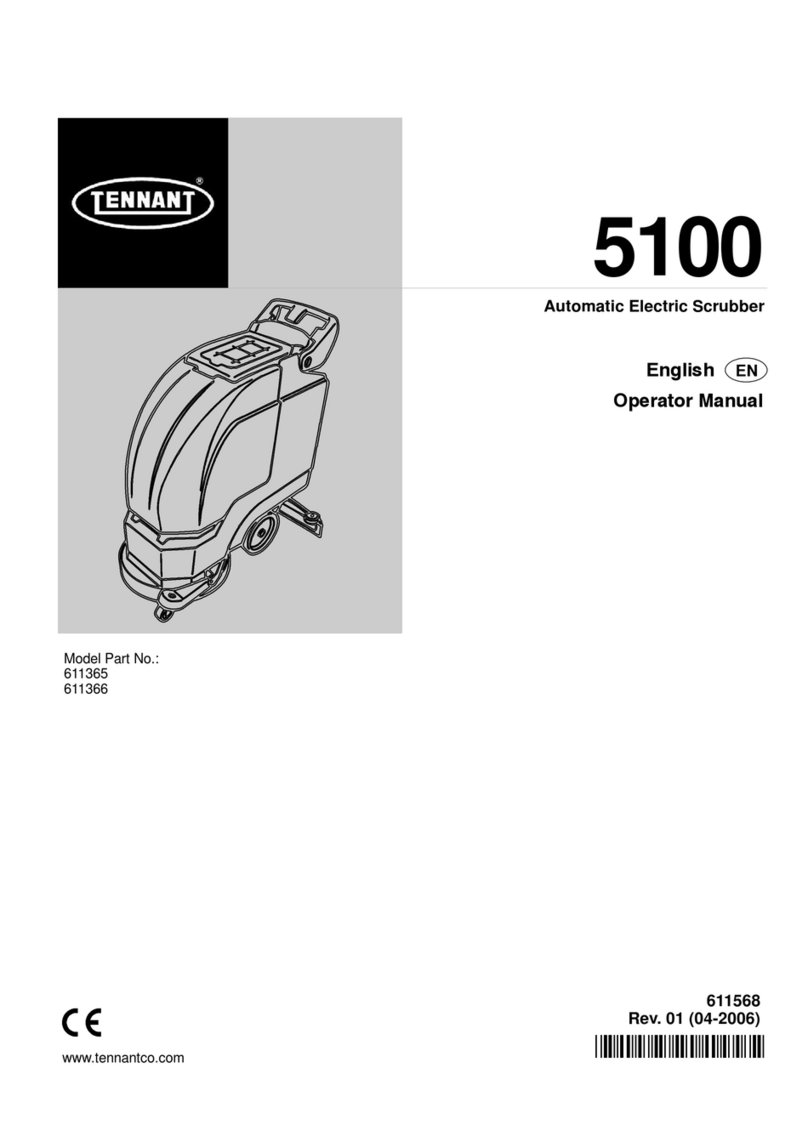
Tennant
Tennant 5100 User manual
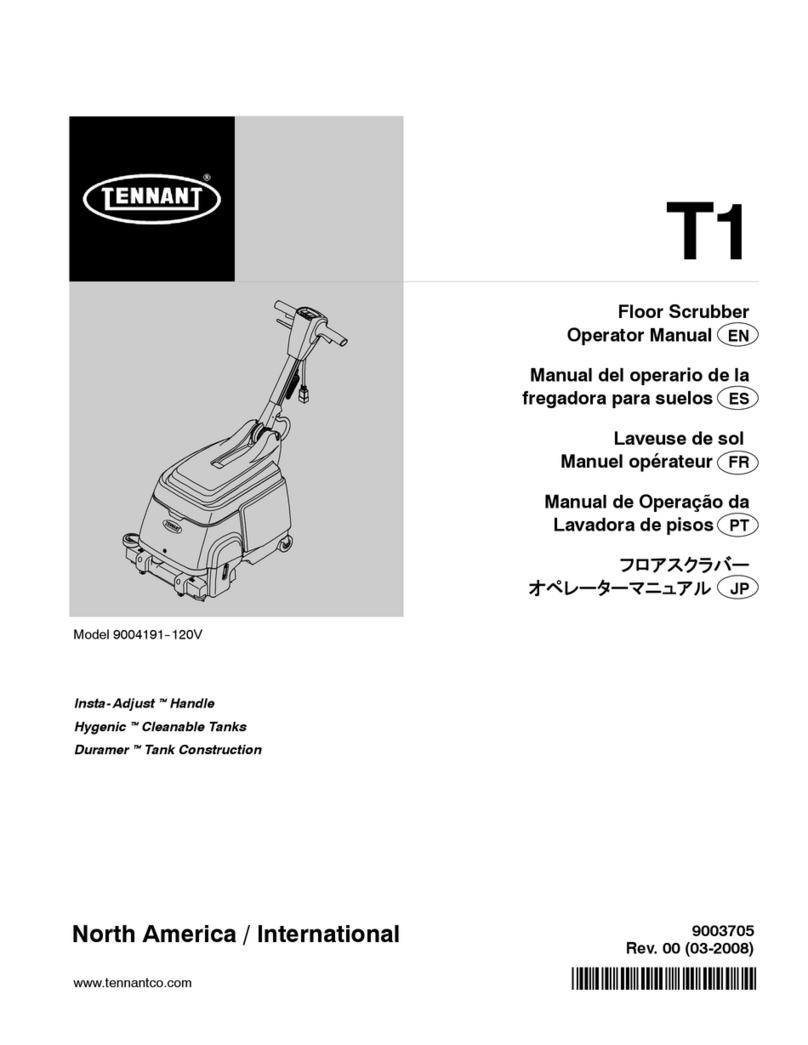
Tennant
Tennant T1 User manual

Tennant
Tennant 5100 Product manual

Tennant
Tennant 242E User manual

Tennant
Tennant 3610 Product manual
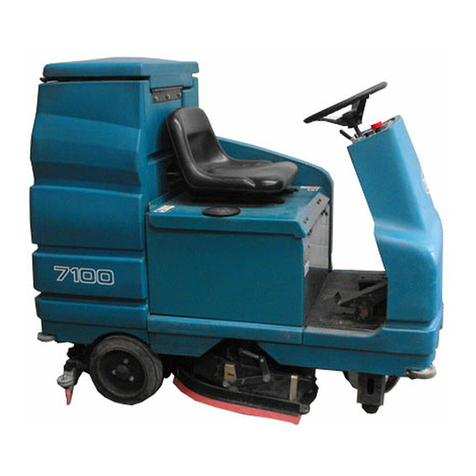
Tennant
Tennant 7100 Training manual
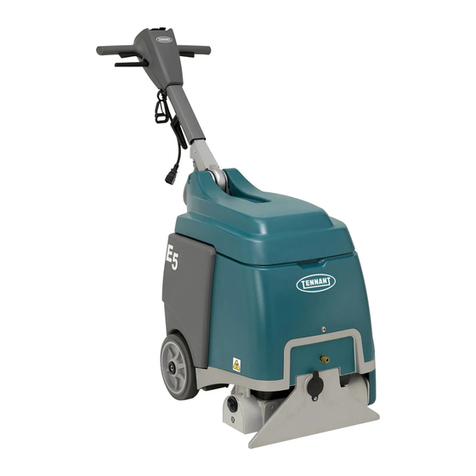
Tennant
Tennant E5 User manual

Tennant
Tennant 1160 Product manual
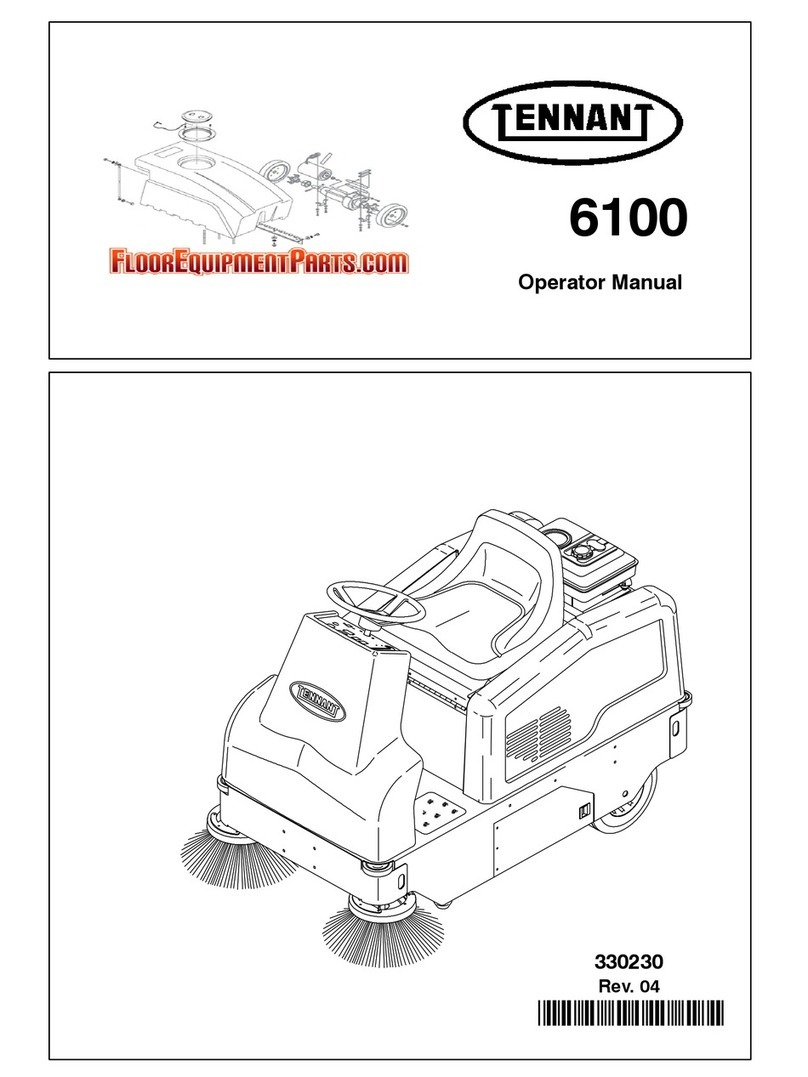
Tennant
Tennant 6100 User manual

Tennant
Tennant 1100 Product manual

Tennant
Tennant S30 Operating and installation instructions
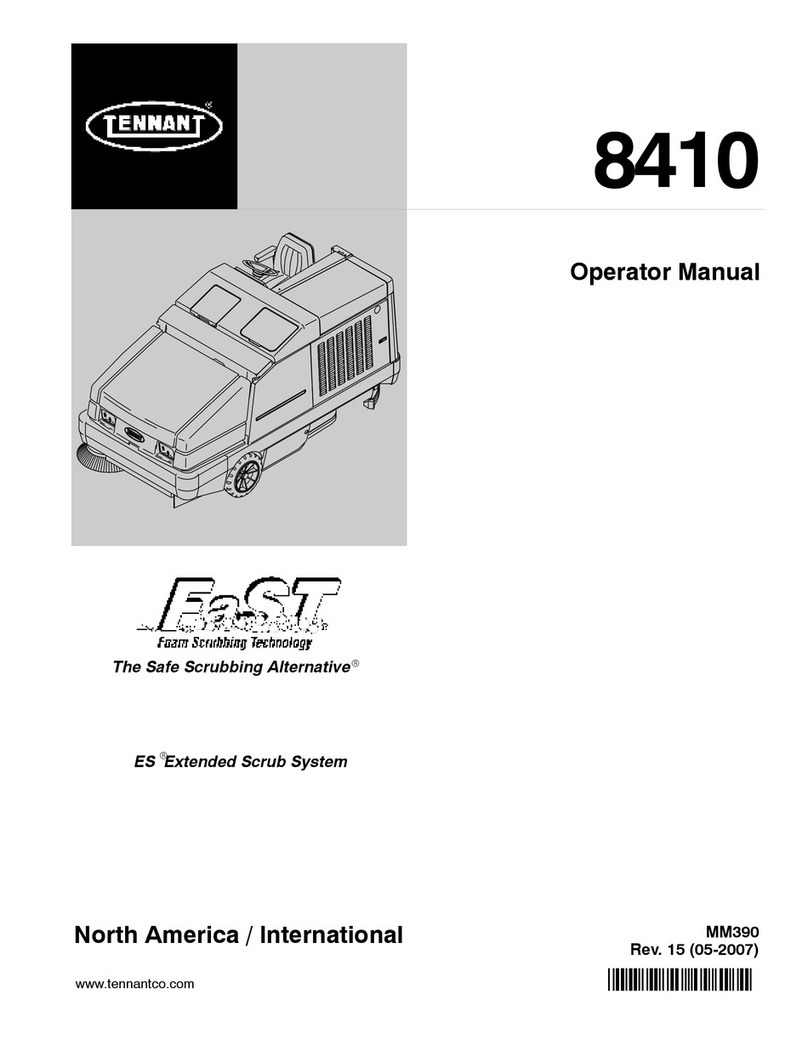
Tennant
Tennant 8410 User manual

Tennant
Tennant BR2020 User manual
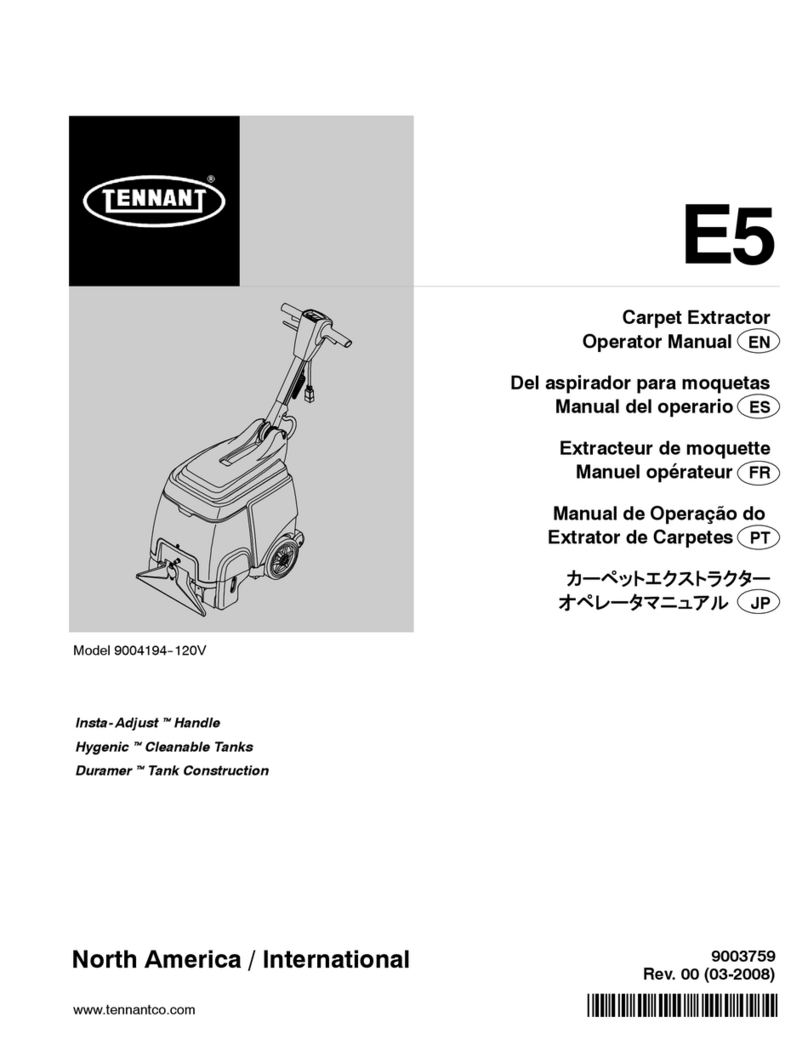
Tennant
Tennant E5 User manual
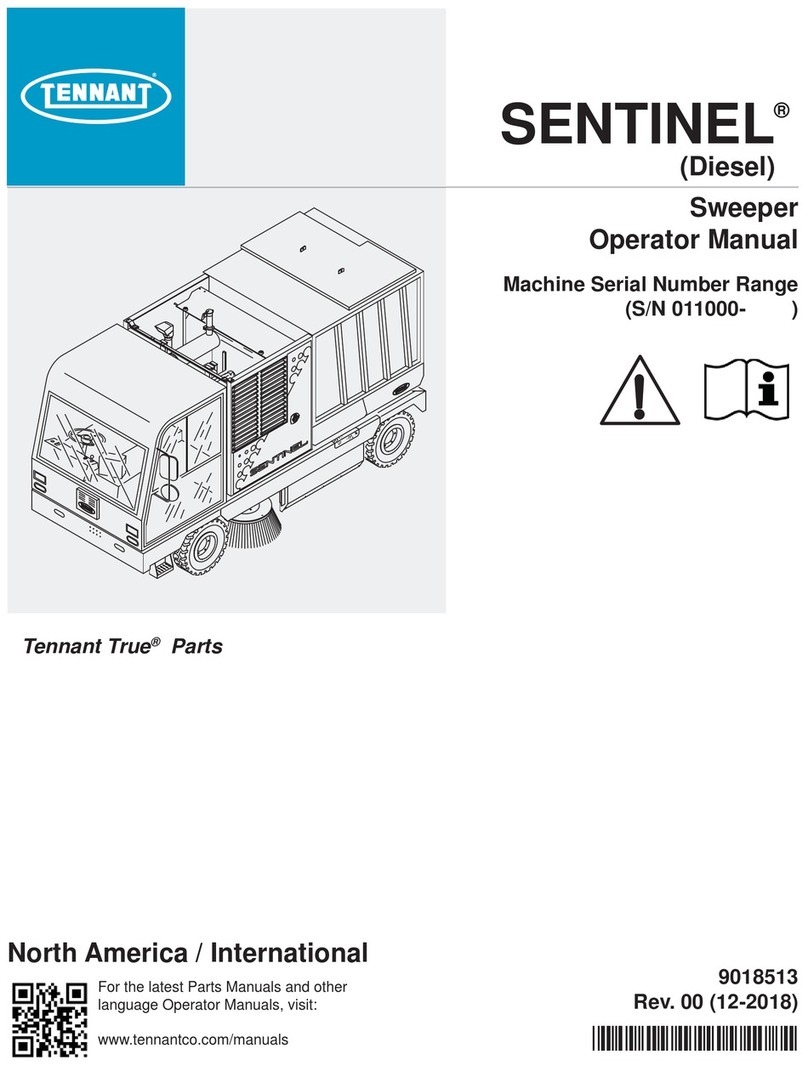
Tennant
Tennant sentinel User manual

Tennant
Tennant 5700 User manual

Tennant
Tennant 800 User manual
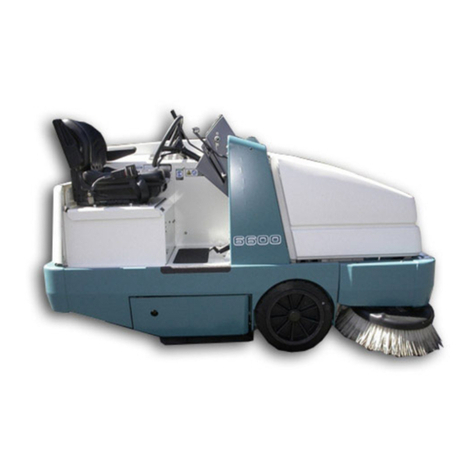
Tennant
Tennant 6600 User manual

Tennant
Tennant 443C User manual

Tennant
Tennant BOSS 2000E Product manual


